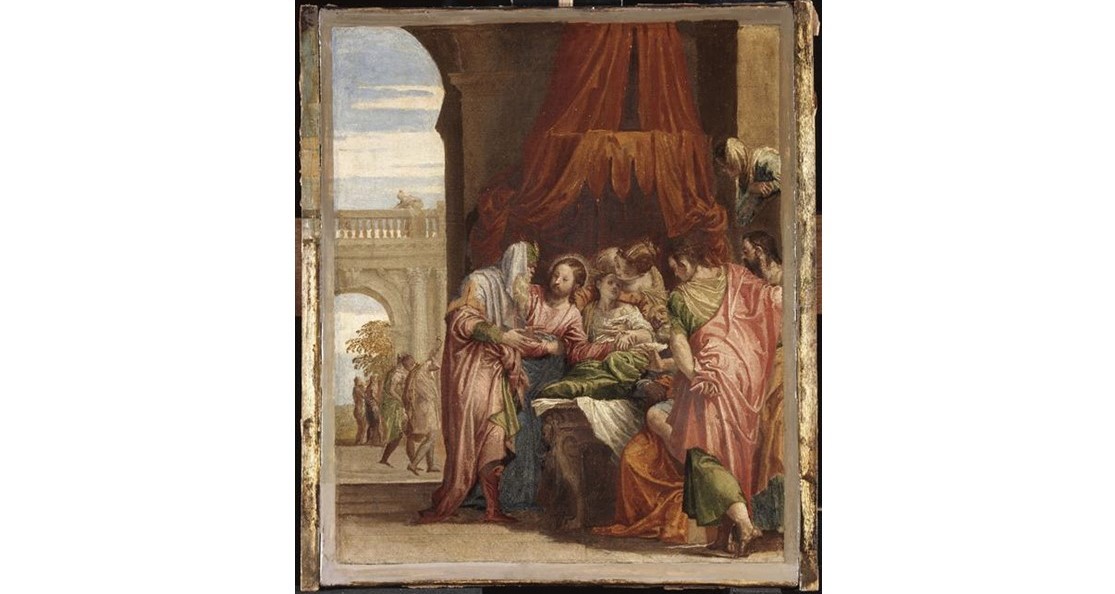+39 0669887260 | info@wucwo.org | Contact us
Art for meditation - December 2023

© 2014 RMN-Grand Palais (musée du Louvre) / Tony Querrec
Veronese, Paolo Caliari called (Verona 1528 - Venice 1588), The Resurrection of the Daughter of Jairus, c. 1546, oil on paper pasted on canvas, 42 x 37 cm, Paris, Musée du Louvre
Women of the New Testament: The Daughter of Jairus.
When Jesus returned, the crowd welcomed him, for they were all waiting for him. And a man named Jairus, an official of the synagogue, came forward. He fell at the feet of Jesus and begged him to come to his house, because he had an only daughter, about twelve years old, and she was dying. As he went, the crowds almost crushed him. And a woman afflicted with hemorrhages for twelve years, who (had spent her whole livelihood on doctors and) was unable to be cured by anyone, came up behind him and touched the tassel on his cloak. Immediately her bleeding stopped.
Jesus then asked, "Who touched me?" While all were denying it, Peter said, "Master, the crowds are pushing and pressing in upon you." But Jesus said, "Someone has touched me; for I know that power has gone out from me." When the woman realized that she had not escaped notice, she came forward trembling. Falling down before him, she explained in the presence of all the people why she had touched him and how she had been healed immediately. He said to her, "Daughter, your faith has saved you; go in peace." While he was still speaking, someone from the synagogue official's house arrived and said, "Your daughter is dead; do not trouble the teacher any longer." On hearing this, Jesus answered him, "Do not be afraid; just have faith and she will be saved." When he arrived at the house he allowed no one to enter with him except Peter and John and James, and the child's father and mother. All were weeping and mourning for her, when he said, "Do not weep any longer, for she is not dead, but sleeping." And they ridiculed him, because they knew that she was dead. But he took her by the hand and called to her, "Child, arise!" Her breath returned and she immediately arose. He then directed that she should be given something to eat. Her parents were astounded, and he instructed them to tell no one what had happened. (Lc, 8, 40-56)
Forty years before painting the Samaritan woman that we saw last November, a very young Veronese, at the beginning of his painting career, barely eighteen years old, offers us this small painting. From the outset, the protagonist is an evangelical scene, from the start protagonist, together with Jesus, is a young woman, whom we see resting in the bed where until a few moments before the master's arrival she was lying dead.
Possibly a preparatory work for a large canvas that we know was commissioned by the Avanzi family for their chapel in the Franciscan church of San Bernardino in Verona, this painting testifies to the painter's already great technical mastery, which, despite the early days, already shows great value.
The scene reproduces the conclusion of the Gospel story and takes place in the intimacy of the Roman officer's house, while outside (we can see this from the architecture and landscape in the background) everything seems to be taking place in normalcy. We have difficulty recognising the characters because the young Paolo does not intend to give consistency or a precise physiognomy to the disciples (Peter, James and John had entered the house, we can distinguish two male figures on the right that could be two of them) nor to the inhabitants of the house (we can imagine that the father and mother are closest to the bed where the daughter lies but there are two other female figures that we are not sure who they are).
Among them all, the figure of Jesus stands out clearly to our eyes: he is at the centre of the painting, his face is surrounded by a halo of light, he wears the clothes of the two traditional colours that already in Byzantine tradition indicate humanity (red) and divinity (blue).
His left hand holds the hand of Jairus' daughter who, still lying on the bed, has just awoken from the sleep of death, has come back to life, returning to her family.
Perhaps the young Paolo felt the figure of the young twelve-year-old girl very close to him, also because of her age, the fact remains that we very much like to conclude this review of women in the New Testament with a girl. December is the month of the celebration of Christmas and it is nice, I think, to contemplate a young girl who, as if by a second birth, has been restored to life. Lastly, an iconographic annotation sourced on the detail of Jesus' hand taking the girl's hand: she found life again the moment she was able to place her hand in the Lord's steadfast and saving hand.
In you, LORD, I take refuge
let me never be put to shame; In your righteousness deliver me;
incline your ear to me; make haste to rescue me!
Be my rock of refuge, a stronghold to save me.
For you are my rock and my fortress, for your name’s sake lead me and guide me.
Free me from the net they have set for me,for you are my refuge.
Into your hands I commend my spirit;
you will redeem me, LORD, God of truth.
(From Psalm 31. 1-5)
(Contribution by Vito Pongolini)